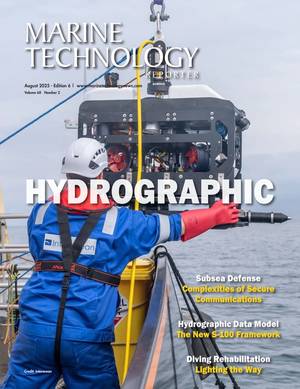
Japan to Begin Test Mining Rare-Earth Mud in Early 2026
said.The mud is believed to contain dysprosium and neodymium, which are used in electric vehicle motor magnets, as well as gadolinium and terbium, used in various high-tech products, Ishii said.Pipes from a deep-sea exploration vessel operated by the Japan Agency for Marine-Earth Science and Technology (JAMSTEC) will be used to extract the mud, which will then be transported to the mainland for analysis to determine its rare earth content.If successful, the project aims to launch trial operations of a system capable of recovering 350 metric tons of mud per day in January 2027.The project is government-funded

JAMSTEC Launches Japan’s First Arctic Research Vessel
The Japan Agency for Marine-Earth Science and Technology (JAMSTEC) has launched Japan’s first Arctic research vessel, named Mirai II.The construction of the Mirai II vessel began in 2021, at Japan Marine United Corporation’s shipyard.The vessel is 128 meters long, with the with of 23 meters, and draft spanning 8 meters.The vessel’s tonnage stands at 13,000 tons, and is said to be capable of continuously breaking 1.2m of flat one-year ice at a ship speed of 3.0kt.Mirai II will be capable of accommodating 97 people on board, including 34 crew members and 63 researchers.The ship is of

Cellula Robotics Sells Seafloor Drill Division to Focus on AUVs
efforts on AUV development and innovation."Previous seafloor drill projects under the Cellula brand included ROVDrill & ROVDrill MkII for Canyon Offshore, subsystems for the Forum M80 and BGS RD2. Cellula's most recent drill developments were the CRD100 drills supplied to Fukada and JAMSTEC in Japan. Cellula said it would continue to support its valued CRD100 clients

JAMSTEC, KAUST Collaborate on Red Sea Research
and expertise are being applied to study areas of the Red Sea, thanks to a partnership between Saudi Arabia and Japan. Researchers at the King Abdullah University of Science and Technology (KAUST) have teamed with engineers and scientists at the Japan Agency for Marine-Earth Science and Technology (JAMSTEC), a leading institute in deep marine science, to advance research in deep-sea and shallow reef environments of the Red Sea.The teaming will enable scientists to investigate some of the sea’s most extreme environments and the marine life adapted to live there. Some of these areas include underwater

Lander Lab #3: Buoyancy
.com> (East Falmouth, MA) has inventory of 12” borosilicate spheres for both flotation and instrument housings. Okamoto Glass Co (Kashiwa, Chiba, Japan) https://ogc-jp.com/en/productinfo/glassball/ makes a line of glass spheres (10-inch, 13-inch, 17-inch) with depth ranges of 4-12km. JAMSTEC’s Edokko Mark-1 lander program utilizes their glass.Figure 7. Precision glass spheres by Nautilus Marine Service. (Photo courtesy of Steffen Pausch, Nautilus Marine Service)Glass provides great compressive strength, is easily formed of readily available materials, can be drilled and

RDSEA "Pic of the Week"
XPRIZE, Runner-Up. The team integrated technologies owned by Japanese universities, institutes and companies for a unique collaborative approach centered around AUVs to compete in the Prize. L-R: Dr. Andrew Remsen (XPRIZE Technical Director on the SOD-Prize), Team Co-Lead: Dr. Takeshi Nakatani (JAMSTEC), Dr. Jyotika Virmani (Executive Dir. SOD-Prize), Rick Cole (RDSEA, SOD-Prize Ops Team), Team Co-Lead: Dr. Takeshi Ohki (JAMSTEC), and Eric Hawk (NOAA Corps., Ret., SeaHawk, LLC, SOD-Prize Ops Team). https://lnkd.in/ePe4-vG

26,322 Ft.: OSIL Giant Piston Corer Breaks Deep-Ocean Sampling Record
Discovery Program (IODP) Expedition 386.The expedition has been staged by the European Consortium for Ocean Research Drilling (ECORD) to gain an insight into the seismic history of the study region off the Japanese coast, and is supported by the Japan Agency for Marine-Earth Science and Technology (Jamstec). On Friday May 14, 2021, the team on board the RV Kaimei recorded an historic sampling water depth of 8,023m (26,322 ft.), and recovered a 37.74m core in a 40m barrel string, a 94.3% recovery rate and record deepest sub-sea level sample (from 8060.74 metres below sea level) from the Giant Piston

NYK receives Accolades for Role in Global Argo Float Program
NYK received an expression of gratitude from the Japan Agency for Marine-Earth Science and Technology (JAMSTEC) for the company’s cooperation with the deployment and operation of Argo floats in support of the global Argo project.An Argo float is a robotic instrument that measures the sea temperature and salinity while drifting with ocean currents at depths up to 2,000 meters below the sea surface. These devices provide the Argo project with data that is analyzed to predict ocean currents and used for the study of climate change, global warming, fisheries, and shipping.The program is an internation

New Corals Discovered at Great Barrier Reef
bottom of the ocean floor, some 1,820 meters deep, the science team examined deep sea bathymetry, wildlife and ecosystems. The collaborative mission brought together scientists from Geoscience Australia, James Cook University, University of Sydney, Japan Agency for Marine-Earth Science and Technology (JAMSTEC), Queensland Museum Network, and Queensland University of Technology, to answer a range of questions about the geological evolution and biology of the deep sea canyons and reefs.Remotely Operated Vehicle SuBastian is moved into position to deploy on Research Vessel Falkor's aft deck. (Photo:


 August 2025
August 2025





